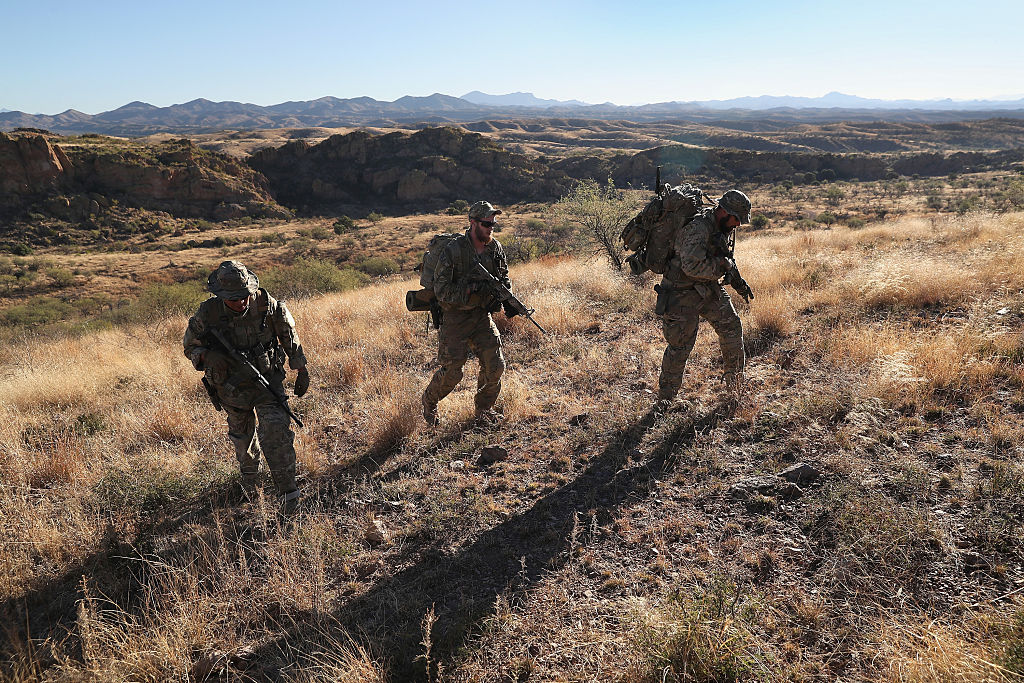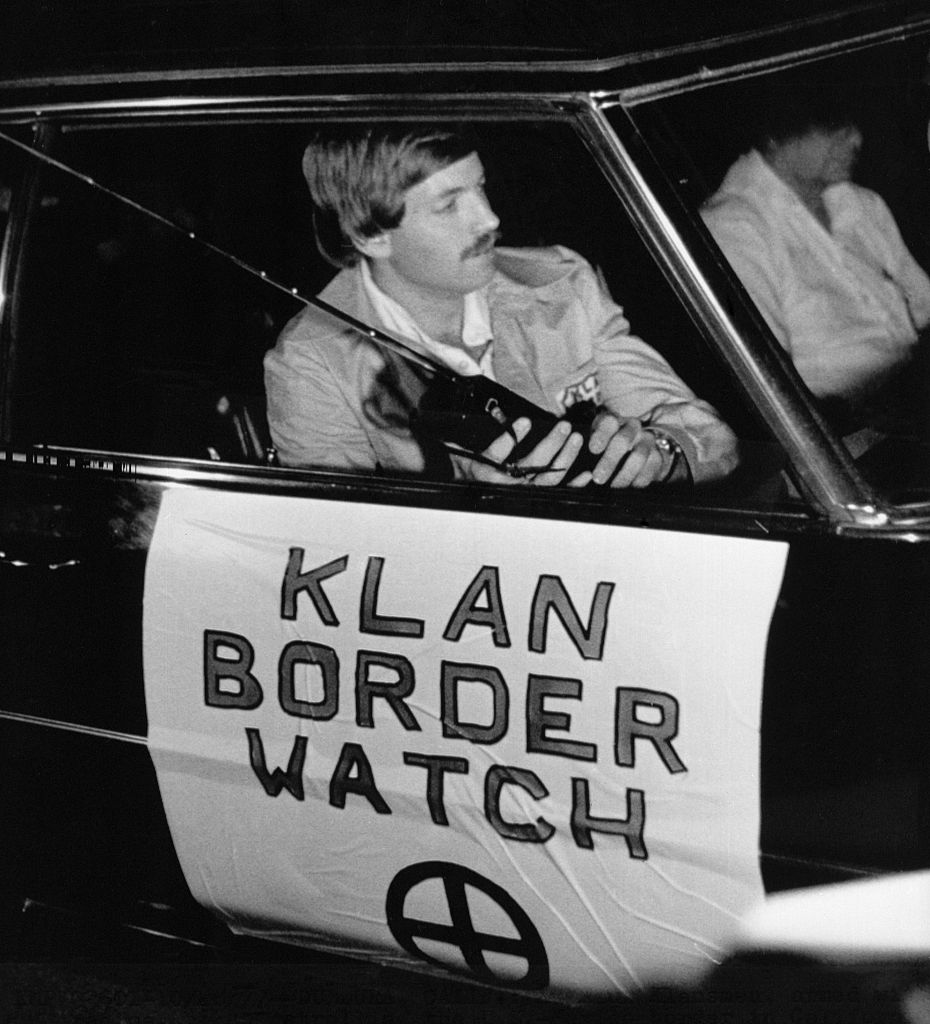
In October 1977, when then Knights of the Ku Klux Klan Grand Wizard David Duke announced plans to trek up and down some 900 miles of the U.S.-Mexico border to hunt down undocumented immigrants, the uproar erupted swiftly. Duke insisted they would report anyone they found to the nearest Border Patrol station.
“We feel this rising tide washing over our border is going to affect our culture,” he told reporters. “All the politicians talk about the problem but do nothing. The politicians in Washington are only interested in potential votes.”
The Klan ultimately failed at preventing crossings in the late 1970s, but the ordeal inaugurated a long history of modern armed vigilantism that persists on the southern frontier today: armed groups continue to crop up in the borderlands, searching for migrants and harassing border communities up and down the line.
During a press conference at the airport in San Antonio at the time, Duke defended his group against accusations that they were merely staging a publicity stunt, claiming 173 Klansmen had already launched patrols.
Tensions soared. The Brown Berets, a militant Chicano group, threatened to rally 1,500 members to face off with the white supremacists. Counter-protesters showed up at crossing points along the frontier. Meanwhile, the affair sparked a diplomatic row with Mexico. When then-Mexican Foreign Secretary Santiago Roel warned he would “protest if there is any case of aggression,” the U.S. ambassador to Mexico at the time, Patrick Lucey, promised the Klansmen wouldn’t be allowed to make good on their plans.
But the operation appeared to be a dud. Some Klansmen drove around the borderlands with a sign that said “Klan Border Watch” taped to the door of their sedan. While some border agents said they spotted a few KKK members in certain Texas border areas, no real vigilante activities ever came to light. “I believe we may have gotten one Klan call last night, but I’m not even sure of that one,” Jim Curr, the then-assistant Border Patrol chief in McAllen, told reporters the day after the Klan patrol kicked off. Of violent incidents, he added, “There’s been nothing. And I doubt seriously if there will be.”

The Klan’s border operation wasn’t the country’s first armed backlash against migration. In the 19th century, the nativists in the Know Nothings had torched Catholic churches and laid sieges to Irish and German neighborhoods from Philadelphia to Louisville, Ky. In the 1850s, Know Nothing affiliates lynched Chinese immigrants in California. In the early 1900s, the U.S. government had dispatched so-called “Chinese catchers” to catch Asian migrants crossing the border into the U.S. After the Mexican Revolution erupted in 1910, American armed forces tried to keep violence from bleeding into states like Texas, and when Mexicans began to flee the conflict, the Texas Rangers and other militia-like groups armed up to prevent them from crossing. In 1924, the U.S. created the Border Patrol, which also sought to block migrants from entering the country.
The vigilantism on the frontier eventually took a turn. In the late 1970s and early 1980s, Texas Knights of the KKK leader Louis Beam, a Vietnam war veteran who had helped organize and promote Duke’s border stunt, established paramilitary camps around Texas and trained children as young as eight in the deadly guerilla warfare tactics he had learned fighting communist rebels overseas. In 1981, he rallied white-robed Klansmen and disgruntled white fishermen against Vietnamese refugees who had legally settled on the Texas coast and who had resorted to shrimping to get by. White fishermen marched, Vietnamese skiffs went up in flames, and Klansmen flooded the town, some showing up equipped with semiautomatic rifles. Beam promised the Vietnamese refugees “a lot better fight here than they got from the Viet Cong.”
When the Southern Poverty Law Center (SPLC) and Vietnamese fishermen sued the Knights of the KKK, Beam was forced to disband his five paramilitary camps around Texas. Beam’s armed groups packed up their camps, but anti-immigrant militias were here to stay.
Read more: The Long History of Vigilante Violence in the U.S.
The militia movement mostly trained its weapons on the federal government throughout the 1990s. The movement rallied against the government after the 1992 Rudy Ridge siege in Idaho, which culminated in a shootout that left the wife and son of white supremacist Randy Weaver dead as well as Deputy U.S. Marshal William Francis Degan. The following year, in Waco, Texas, militias flocked to support the Branch Davidian cult members during the 51-day siege of their compound. When the feds eventually raided the spot, gun battles broke out and fires were set, and dozens of Branch Davidians and four federal agents died.
In the early 2000s, vigilantes again set their sights southward. Equipped with paramilitary gear and lugging their weapons through the rough borderlands, militiamen sought to track down immigrants crossing the border, sometimes detaining them. These vigilante operations often ended with violence.
After 9/11, the administration of President George W. Bush aimed to tighten security on the northern and southern borders alike. Bush promised to push realistic immigration policy and eventually condemned the groups gallivanting in the desert. “I’m against vigilantes in the United States of America,” Bush said at a press conference with the Mexican president in March 2005. “I’m for enforcing the law in a rational way.”
But those groups had their own plans. In 2003, members of an armed group called Rescue Ranch had stumbled upon a Salvadoran couple near the Texas-Mexico border, chased down the pair, and detained them at gunpoint. One militiaman beat the pair with the butt of a gun.

Meanwhile, the number of anti-immigrant groups continued to grow, with a sharp surge in activity after Barack Obama’s election. Obama may have earned the nickname “deporter-in-chief” among immigrant rights groups, but the far right wasn’t concerned with facts. Egged on by politicians like then-Texas Governor Rick Perry, who claimed Obama “orchestrated” the arrival of undocumented children, and false claims that Obama himself wasn’t an American-born citizen, border vigilantes seized the paranoia of the time. While some of the militias fashioned themselves as mere conservatives and patriots, others had well-documented histories in neo-Nazi and white nationalist outfits. As far back as 2005, the SPLC had reported that neo-Nazis from the National Alliance had infiltrated the anti-immigrant Minuteman Project, but hardline white supremacists would increasingly try to latch to the border militias. J.T. Ready, a border vigilante who later killed himself and several others in a shocking act of domestic violence, had once belonged to the National Socialist Movement.
In May 2009, rogue anti-immigrant militiamen in Southern Arizona carried out a shocking double murder. Led by a Washington émigré named Shawna Forde, they planned to rob a local drug dealer, sell his stash, and use the funds to buy more arms and beef up their border patrols. The FBI had been tipped off about the group’s plans, but nothing was done to stop them. On May 30, they disguised themselves as Border Patrol and showed up at the home of Raul Flores, Jr. in Arivaca, a small community about 12 miles from the Arizona-Mexico border. They didn’t find much money, but they shot and killed Flores and his nine-year-old daughter, Brisenia.
Throughout the Obama years, the border vigilante movement continued to mushroom. Some groups landed profiles in magazines and newspapers around the country. Their jingoism dovetailed with their anti-government views, and some continued to hunt and detain immigrants who had crossed into the country. In 2014, ATF agents in Brownsville, Texas, nabbed Kevin “K.C.” Massey, a Texas militiaman who, along with others, had spent months detaining migrants. After he and another man had been involved in an armed standoff with a Border patrol agent, the ATF found in Massey’s motel room what they believed to be bombmaking materials and thousands of rounds of ammunition. He was convicted of being a felon in possession of a firearm and sent to prison, but once he got out, he went on the lam and promised a deadly shootout with federal agents if they caught up with him. The manhunt came to an end when Massey shot and killed himself in East Texas’s Van Zandt County in December 2019.
Get your history fix in one place: sign up for the weekly TIME History newsletter
With Donald Trump overseeing one of the most anti-immigrant administrations to date, border vigilantism again hit a fever pitch. Trump had promised to build a wall on the U.S.-Mexico border and deport undocumented immigrants en masse. When the midterm elections came in fall 2018, the president drummed up widespread fear over a so-called caravan of refugees and migrants heading toward the border, deeming it an “invasion.” Unsurprisingly, militias from around the country saw his rhetoric as a war cry and flocked to the southern frontier.
Around that time, in Arivaca, Ariz., new militias and vigilantes showed up, reopening old wounds with the community. Many locals rallied to push the armed groups out, but some militiamen remain there until today. Arizona Border Recon even established a base in the town. Although Arizona Border Recon disputes the “militia” label, there’s hardly a better word for a group of civilians that arm up and go on patrols of the borderlands.
In New Mexico, Larry Hopkins and his United Constitutional Patriots armed group rounded up and detained a large group of migrants in April 2019. Not long after he was arrested, the FBI said that Hopkins and others had trained to assassinate former President Obama, former Secretary of State Hillary Clinton and billionaire philanthropist George Soros.
Now, more than a year into Joe Biden’s presidency, the militia threat hasn’t gone away. Apprehensions on the southern border have swelled, and with Republicans falling back on the same anti-immigrant playbook Trump so often relied on, some armed groups are once again traveling south. In South Texas, some vigilantes are already showing up in areas where migrants are trying to cross. In Southern Arizona, far-right militia outfits are increasingly targeting migrants, fueled by QAnon-linked conspiracy theories.
Sure, it’s easy to dismiss some of the vigilantes as grifters and clout-chasers, but in the decades since the Klansmen first carried out their patrols in the borderlands, the movement has taught us one thing: Ignoring them could cost lives.
More Must-Reads from TIME
- Caitlin Clark Is TIME's 2024 Athlete of the Year
- Where Trump 2.0 Will Differ From 1.0
- Is Intermittent Fasting Good or Bad for You?
- The 100 Must-Read Books of 2024
- Column: If Optimism Feels Ridiculous Now, Try Hope
- The Future of Climate Action Is Trade Policy
- FX’s Say Nothing Is the Must-Watch Political Thriller of 2024
- Merle Bombardieri Is Helping People Make the Baby Decision
Contact us at letters@time.com